Meiji Jingu Shrine is one of Tokyo’s most visited religious sites, holding a prominent position in Japan’s cultural and spiritual landscape. Located near the bustling Shibuya district, this Shinto shrine offers an interesting contrast to the city’s modernity. Visitors come here for a range of reasons: some seek a deeper understanding of Shinto practices, while others are interested in the shrine’s historical significance or its natural surroundings.
In this comprehensive article, you’ll find information covering all these aspects and more, from the shrine’s origins and architectural details to how to reach it via public transport. I will also explain more about the various ceremonies and rituals that take place here, providing tips on how to fully engage with the site.
Whether you’re planning a trip or are simply curious about what makes Meiji Jingu Shrine so special, this guide aims to offer a thorough overview.
Table of Contents
- About Meiji Jingu
- Layout and architecture
- What to see at Meiji Jingu
- Sake Barrels
- Purification Rite
- The divine trees
- Ema
- Weddings
- Rituals at Meiji Jingu Shrine
- Location and Access for Meiji Jinju
- Travel Tips
- Food and souvenirs
- Entrance Fees and Hours
- Meiji Jingu Shrine
- Inner Garden
- Meiji Museum
- Frequently Asked Questions
About Meiji Jingu
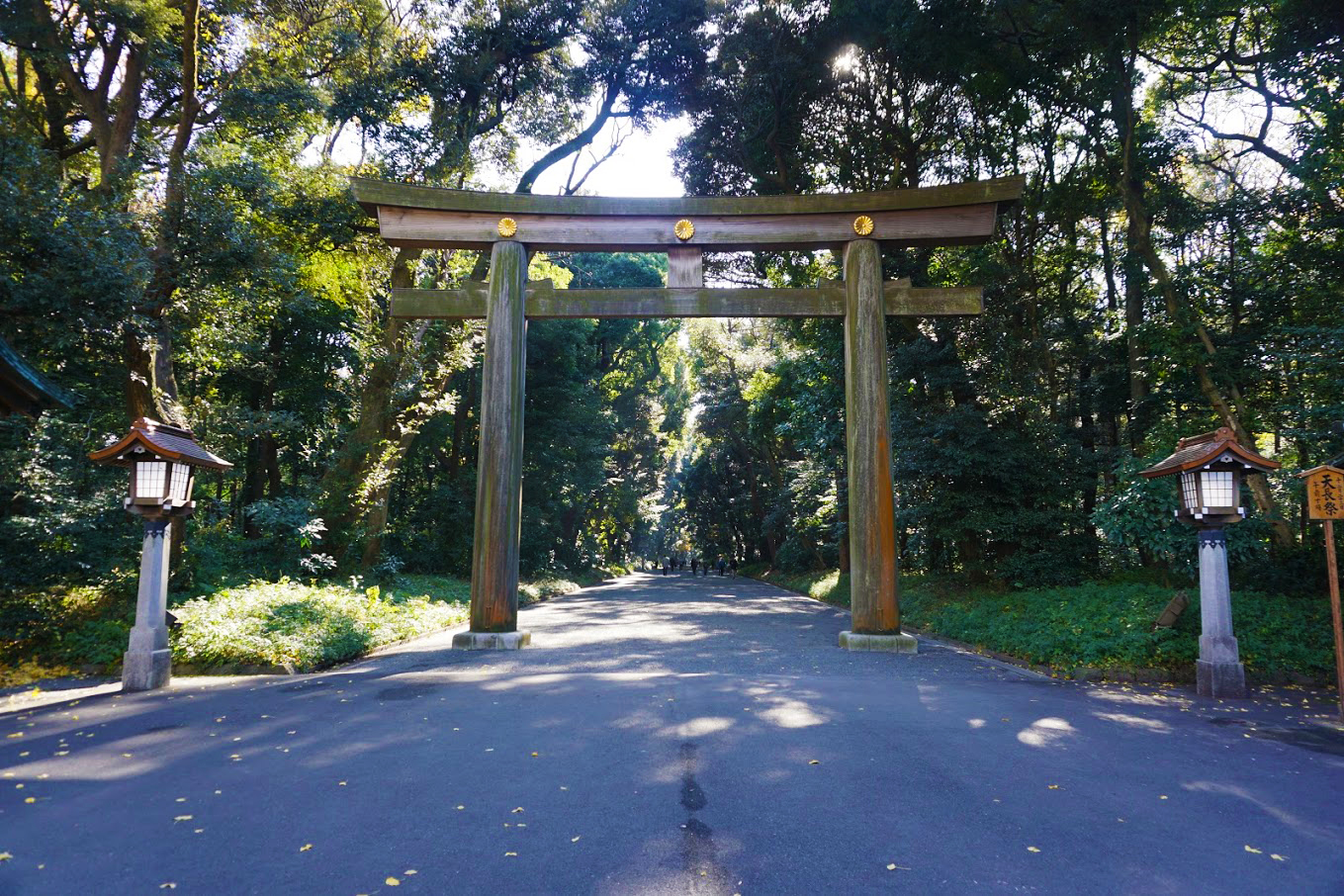
Meiji Jingu Shrine was established in 1920, in memory of Emperor Meiji and Empress Shoken. This was eight years after Emperor Meiji passed away and six years after the death of Empress Shoken. Although the original structure was destroyed during the Second World War, it was quickly rebuilt and continues to be a prominent Shinto shrine today.
Emperor Meiji holds a crucial role in Japanese history. Born in 1852, he came to the throne in 1867, a pivotal moment known as the Meiji Restoration. This period marked the end of Japan’s feudal era and the return of direct imperial rule. Under Emperor Meiji’s leadership, Japan underwent significant changes that moved the nation from a feudal society to a modern state, aligning itself with major global powers. His reign saw the introduction of various reforms that impacted law, education, and the military, transforming Japan into a world power by the time of his death in 1912.
Empress Shoken, his consort, also contributed to public welfare and was involved in various charitable activities. Her contributions are equally commemorated at the shrine.
Layout and architecture
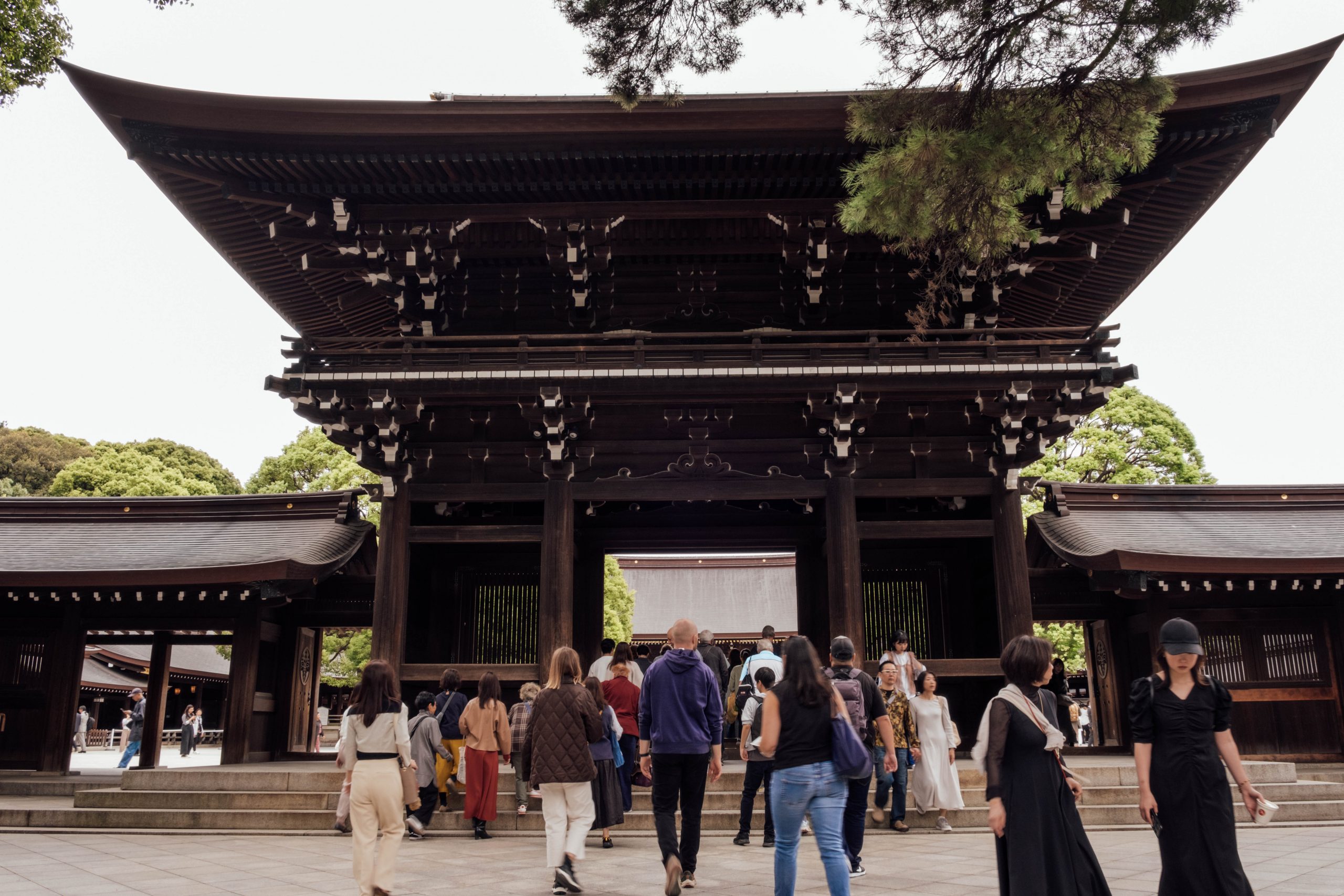
Meiji Jingu Shrine is a great example of traditional Japanese architecture and design, offering a unique layout that emphasizes harmony with nature. You will first enter the shrine grounds and the first thing you’ll encounter is the large wooden gate known as the Torii. Made from cypress wood, the Torii serves as a symbolic separation between the earthly world and the sacred grounds of the shrine. Do not touch the torii. It is customary to bow as you pass through.
Past the Torii, a gravel path leads you through a lush forest toward the central area of the shrine. This forest is significant as it was intentionally planted when the shrine was established and consists of a variety of tree species donated from all over Japan. It aims to showcase the nation’s diverse natural beauty within the confines of the shrine, right in the heart of Tokyo.
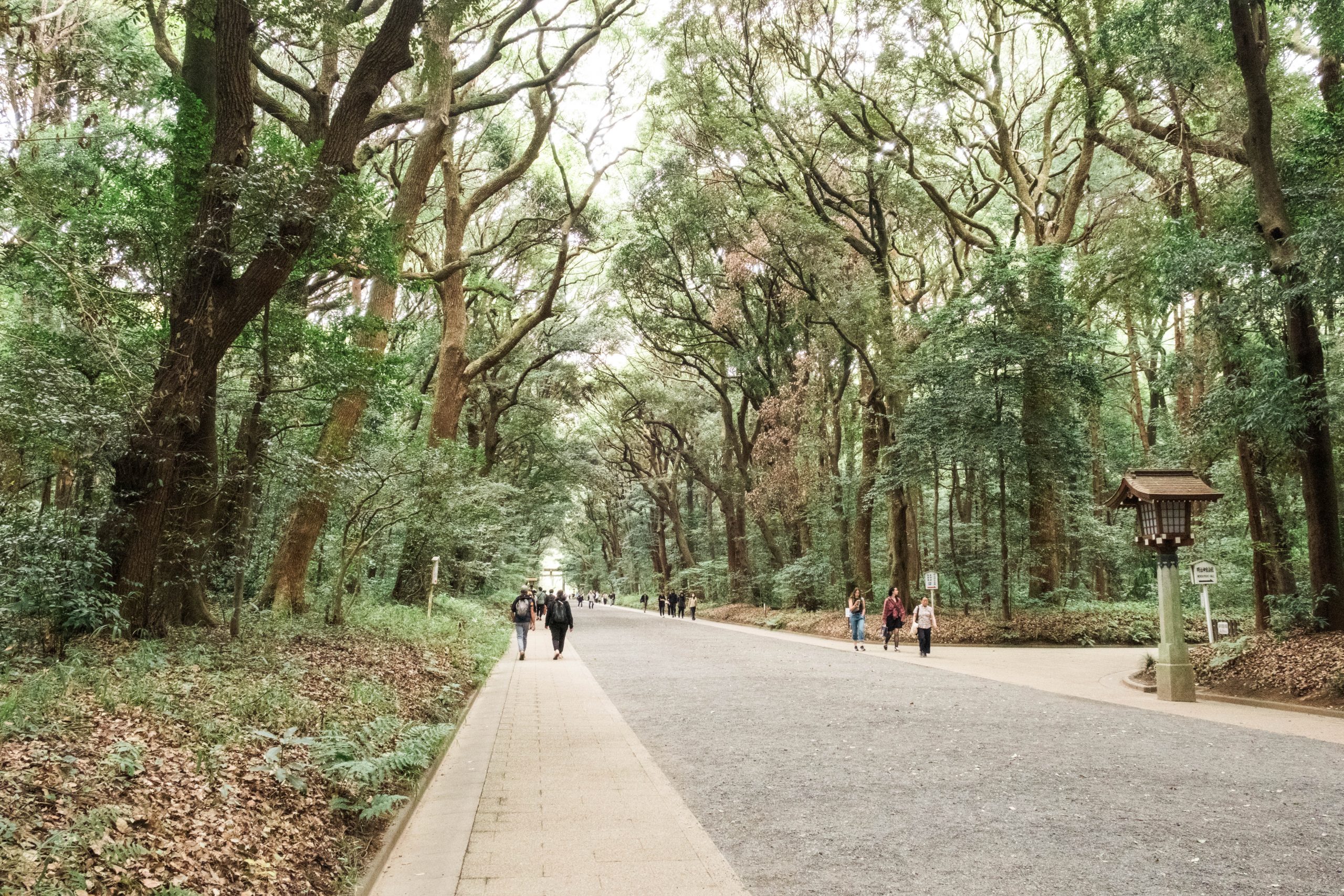
The central area of the shrine features multiple structures but two of the most important ones are the Main Hall (Honden) and the Inner Garden (Oku-no-in).
The Main Hall is where religious ceremonies take place and prayers are offered. Like the Torii gate, the Main Hall is primarily constructed from Japanese cypress wood and follows the Nagarezukuri architectural style, which is characterized by its simplicity and emphasis on natural materials. The Honden is where the deities are enshrined and is generally not open to the public, but visitors can pray and make offerings at a designated area in front of it.
Adjacent to the central area where the Main Hall (Honden) is located, you’ll come across the Meiji Jingu Museum. Opened in 2019 and designed by the renowned architect Kuma Kengo (who also designed SunnyHills Aoyama and Nezu Museum), this museum is a treasure trove of artefacts. The museum showcases items from the shrine’s own collection, including personal belongings of Emperor Meiji and Empress Shoken. One of the highlights is the carriage used by Emperor Meiji for the formal declaration of the Meiji Constitution in 1889.
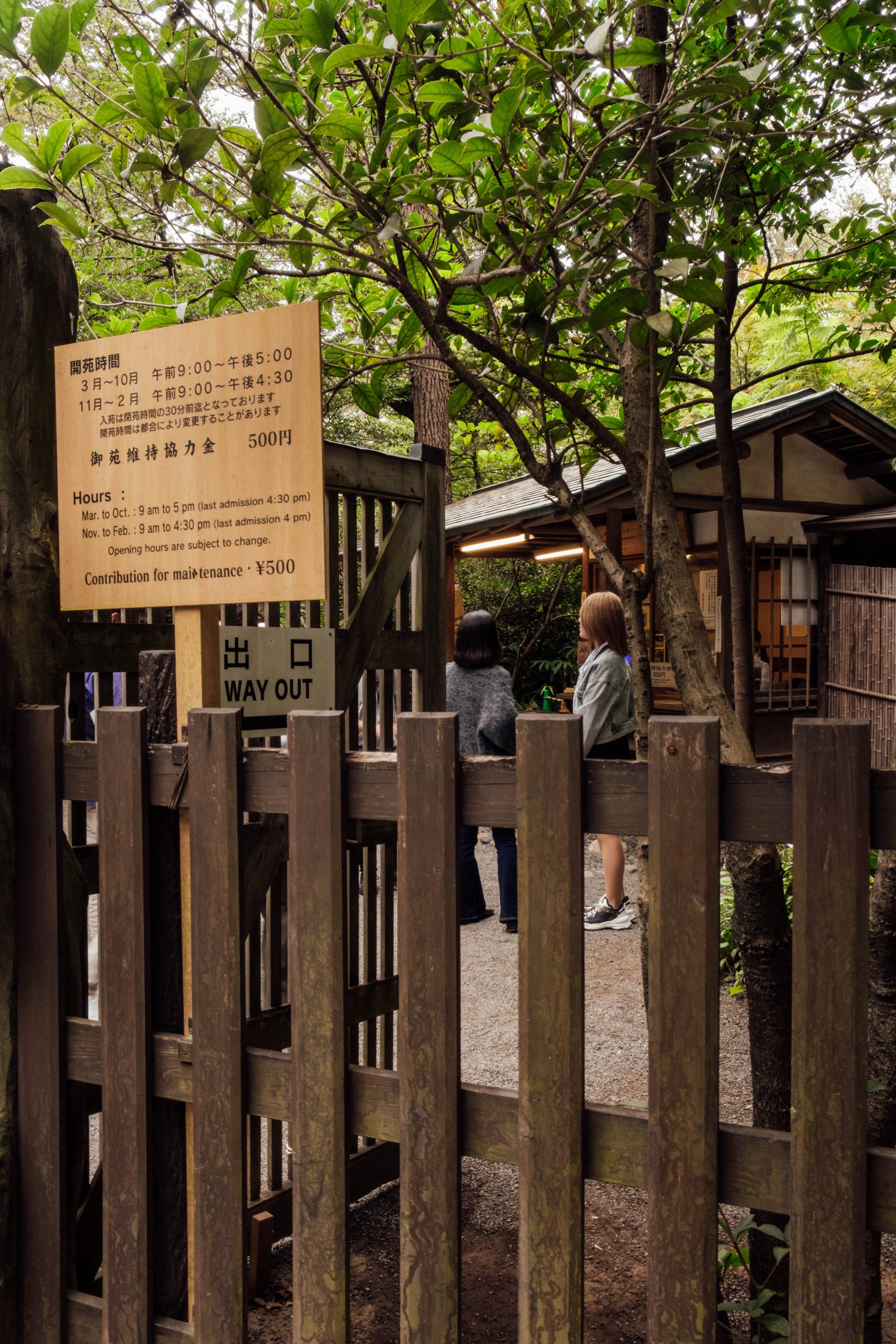
Adjacent to the Main Hall is the Inner Garden, a meticulously maintained space featuring seasonal flowers. The garden is often a place for quiet reflection and offers another layer of interaction for visitors who want to engage more deeply with the shrine’s spiritual environment.
What to see at Meiji Jingu
Sake Barrels
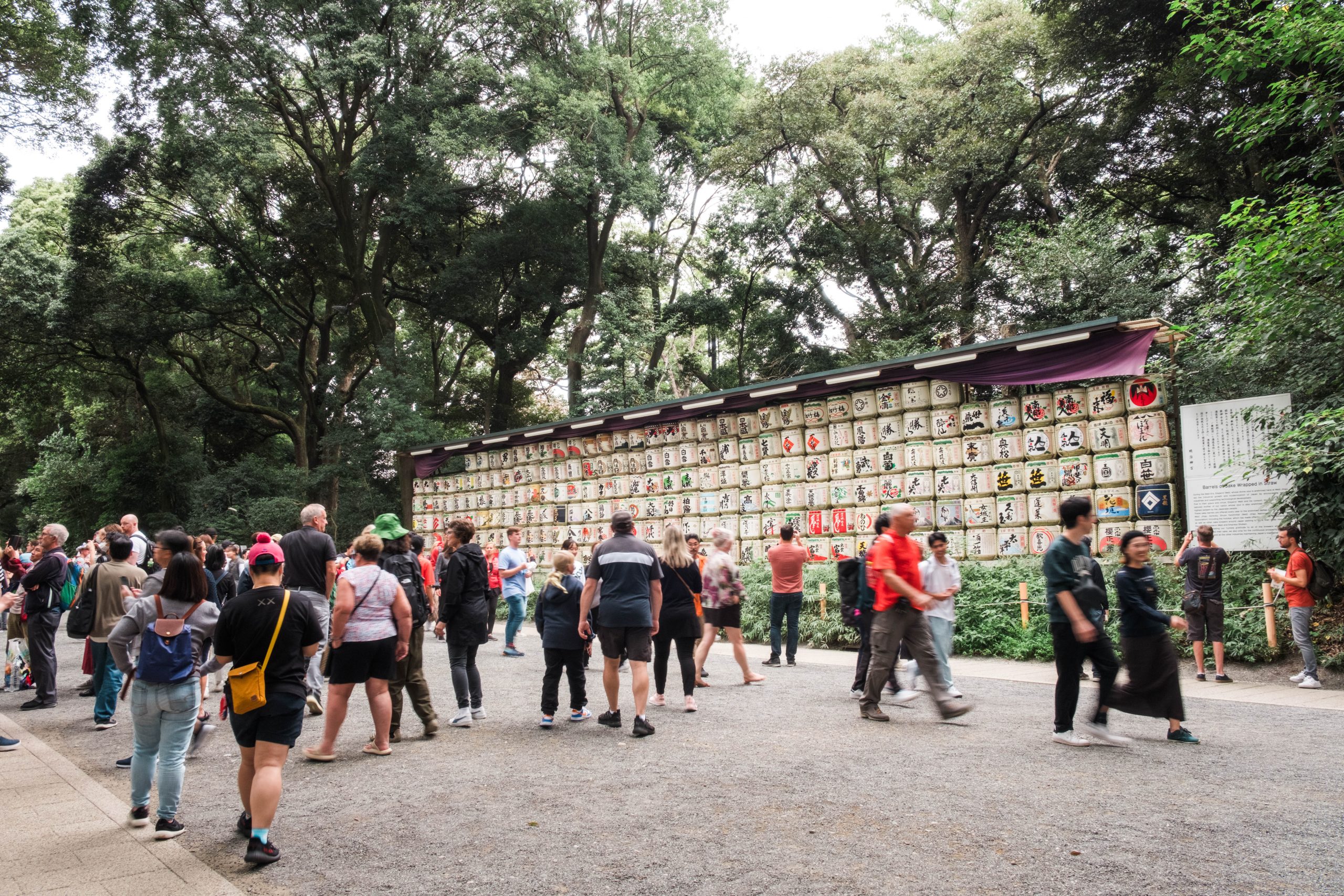
One of the first things you might notice as you approach the shrine are the decorative sake barrels, known as “kazaridaru.” These barrels are a display of offerings to the deities enshrined in Meiji Jingu. Sake, or rice wine, holds a significant place in Shinto rituals, symbolizing purification and the connection between humans and gods. The barrels are often donated by sake brewers from around Japan and are aesthetically pleasing, adorned with intricate designs.
Purification Rite
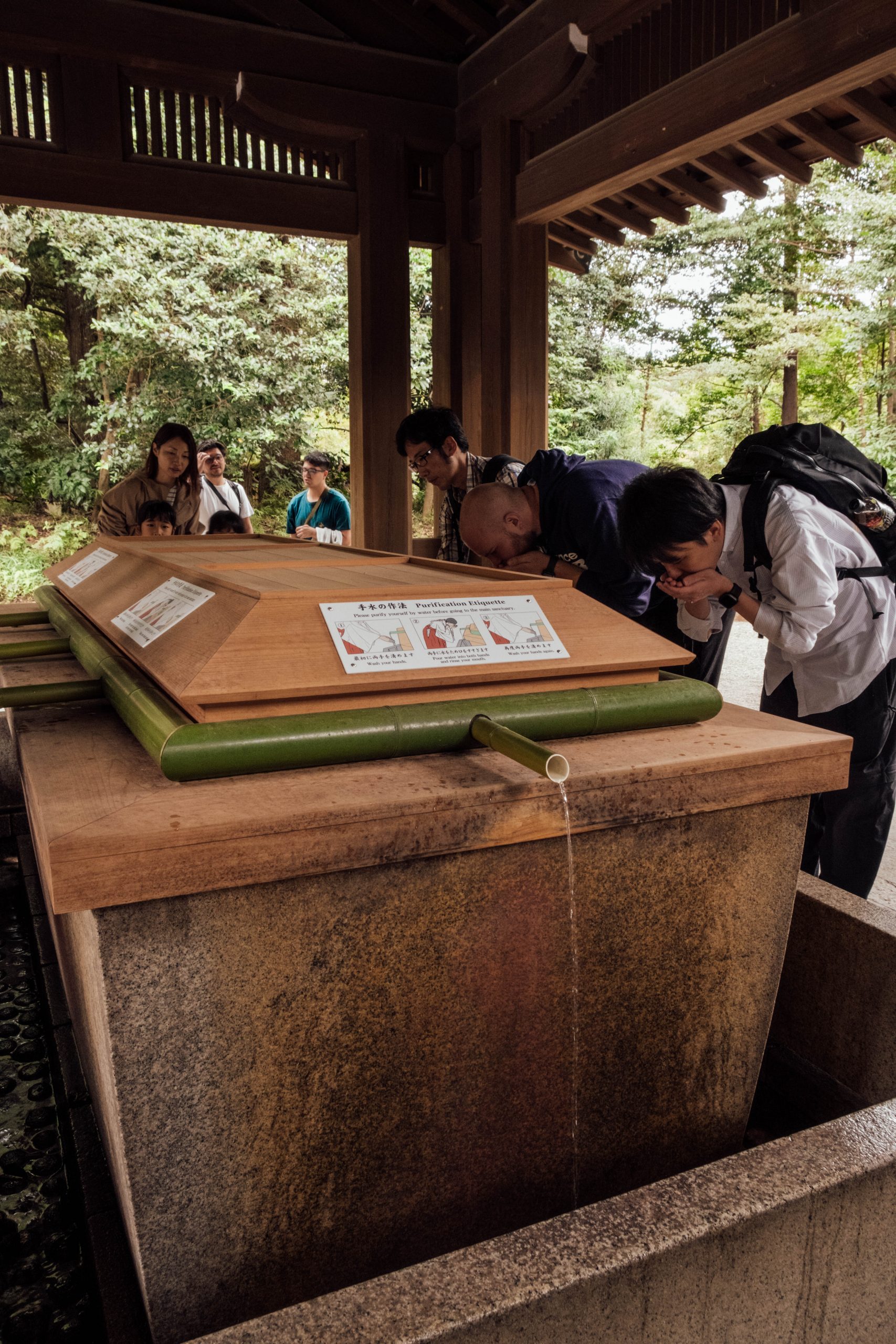
Before entering the main shrine area, you’ll encounter a purification fountain, or “temizuya,” where you can cleanse yourself physically and spiritually. Visitors are encouraged to rinse their hands and mouth to purify their body and mind before proceeding to the main shrine. Here is how to use temizuya at Meiji Jingu Shrine.
- Offer a small bow before you get close to the water basin.
- Use a ladle to scoop up water and rinse your left hand.
- Transfer the ladle to your left hand and rinse your right hand.
- Switch the ladle back to your right hand, cup your left hand, and collect some water to rinse your mouth.
- Cleanse your left hand one more time.
- Hold the ladle upright, allowing any leftover water to flow down the handle, cleansing it for the next visitor.
- Place the ladle back where you found it.
- Offer another small bow as you step away from the water basin.
The divine trees
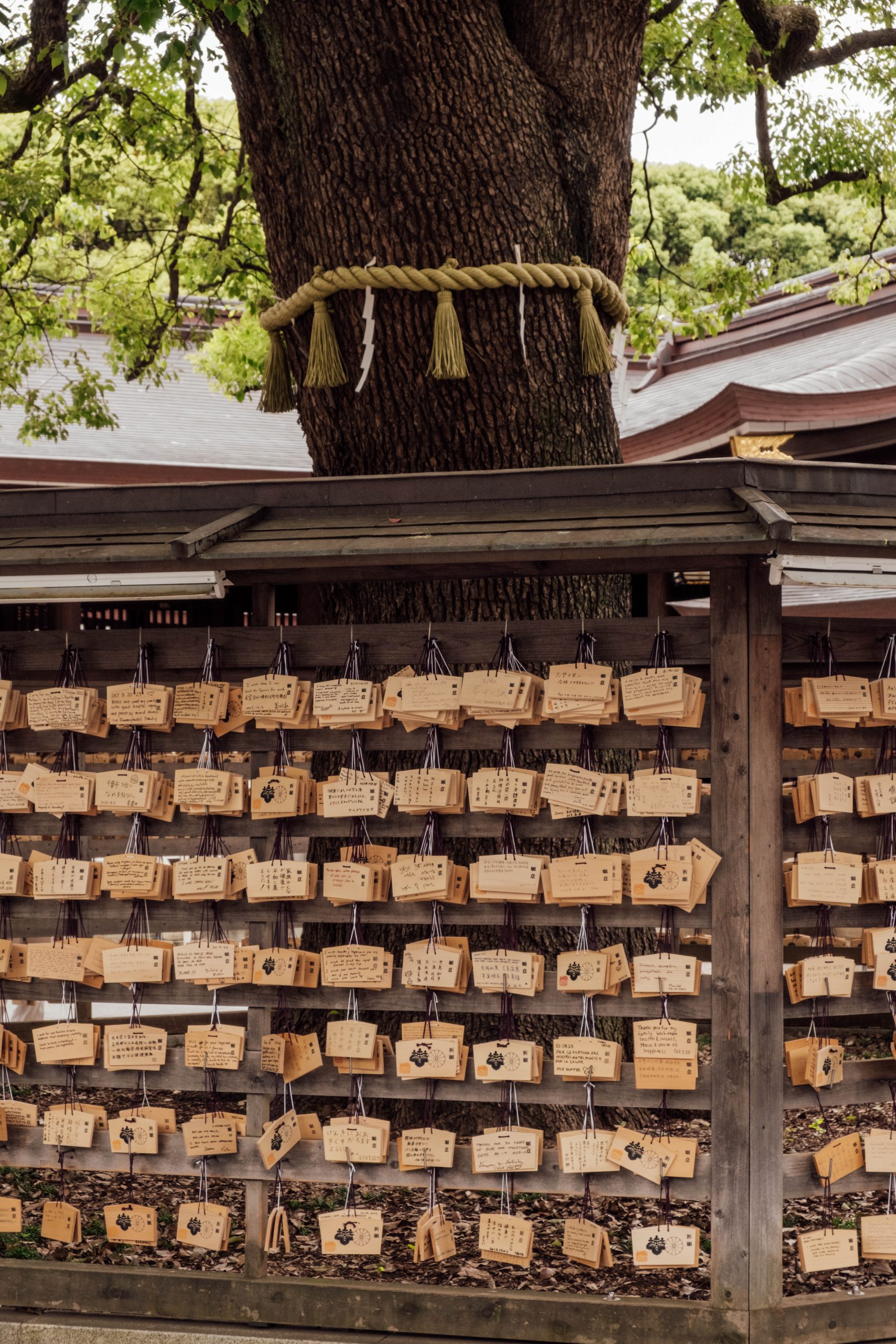
Meiji Jingu Shrine is surrounded by a lush, man-made forest with over 100,000 trees donated from regions across Japan. Among these, there are some labeled as “divine trees,” considered particularly sacred and often adorned with “shimenawa” (sacred ropes) and “shide” (paper zigzag streamers). These trees are believed to possess spiritual significance and to create a beautiful and strong relationship between husband and wife.
Ema
Ema are small wooden plaques where visitors can write down their wishes or prayers. These are then hung on designated boards within the shrine’s precincts, with the belief that the enshrined deities will receive and possibly fulfil these wishes. To do this, first head to the counter and purchase your own ema. Use the pens provided around the shrine and write down your wish. Hung the ema along the others and allow for the spirits to take care of you wish.
Weddings
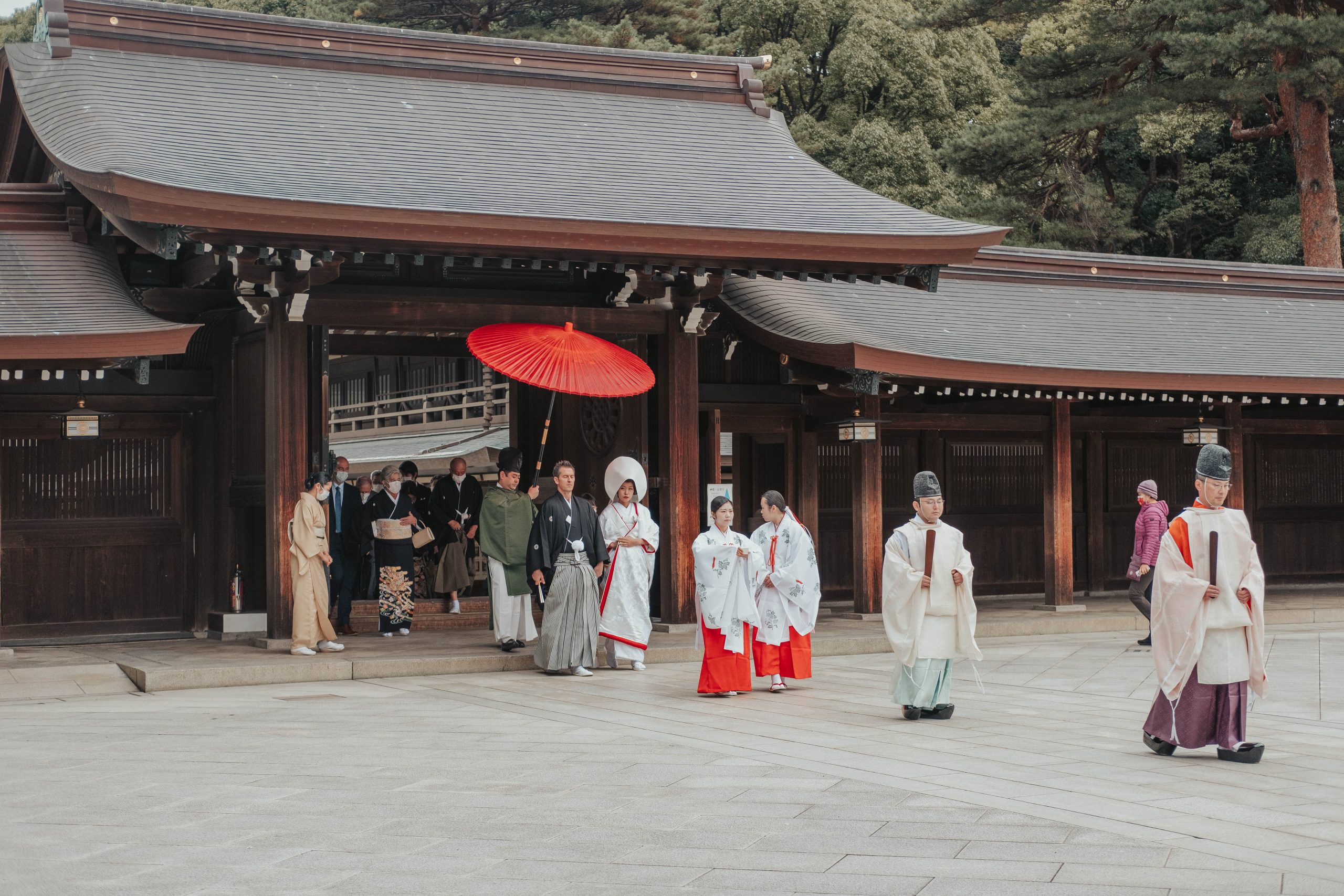
Meiji Jingu Shrine is a popular venue for traditional Shinto weddings. You might be lucky enough to witness such a ceremony. The bride, groom, and their families participate in a solemn procession through the shrine grounds, often attracting the attention of other visitors. The ceremonies are considered private affairs, but they do add to the cultural richness of a visit to the shrine.
Please keep your distance and respect the privacy. Do not use flash for photography if you decide to take any pictures of the couple.
Rituals at Meiji Jingu Shrine
| Month | Ritual or Event | Time | Description |
|---|---|---|---|
| Daily/Frequent/Upon Request | Nikku-sai | 8 am, 2 pm | Daily ritual |
| Tsukinami-sai | 9 am | Held on the 1st and 15th of each month | |
| Kigansai | Varies | Private prayers with Shinto rites based on requests | |
| January | Saitan-sai | 7 am | New Year’s Day ceremony |
| Hatsumoude | Varies | New Year shrine visits | |
| Kakizome | N/A | Student calligraphy exhibition (Jan 5-31) | |
| Dezuiri | N/A | Sumo Grand Champion “Ring Entering” Ceremony | |
| February | Kigen-sai | 10 am | Marks the enthronement of Emperor Jimmu |
| Kinen-sai | 10 am | Prayer ceremony for agricultural fertility | |
| Tencho-sai | 10 am | Current Emperor’s birthday | |
| March | Hinamatsuri | N/A | Doll Festival for girls’ health |
| April | Shokenkotaigo-sai | 10 am | Memorial ceremony for Empress Shoken |
| May | Sukeishatai-sai | 10 am | Spring Grand Festival |
| Kodomo-no-matsuri | N/A | Festival for children’s health | |
| June | Irises Viewing | N/A | Irises are in full bloom |
| Great Purification Ceremony | 2 pm | Held on June 30th | |
| July | Tanabata-matsuri | N/A | Star Festival for children |
| Meijitenno-sai | 9 pm | Marks the passing of Emperor Meiji | |
| October | Ningyo Kansha-sai | N/A | Festival to thank dolls |
| Ceremonial recital of poems | 10 am | Ritual to recite poems to the Kami | |
| November | Ritual Ceremony for Meiji Jingu Enshrinement Anniversary | 10 am | Marks the shrine’s establishment |
| Autumn Grand Festival | 10 am | Marks the birthday of Emperor Meiji | |
| Niiname-sai | 10 am | The Harvest Festival | |
| December | Great Purification Ceremony | 2 pm | Year-end purification |
| Joya-sai | 4 pm | Year-end ritual |
Location and Access for Meiji Jinju
Meiji Jingu Shrine is located in Shibuya, Tokyo, near the bustling district of Harajuku. It is easily accessible via public transport. I always recommend adding Meiji Jinju to your Tokyo itinerary list.
By Train: The closest train stations are Harajuku Station on the JR Yamanote Line and Meiji-Jingumae Station on the Chiyoda and Fukutoshin Subway Lines.
Walking: It’s within walking distance from popular areas like Harajuku and Omotesando.
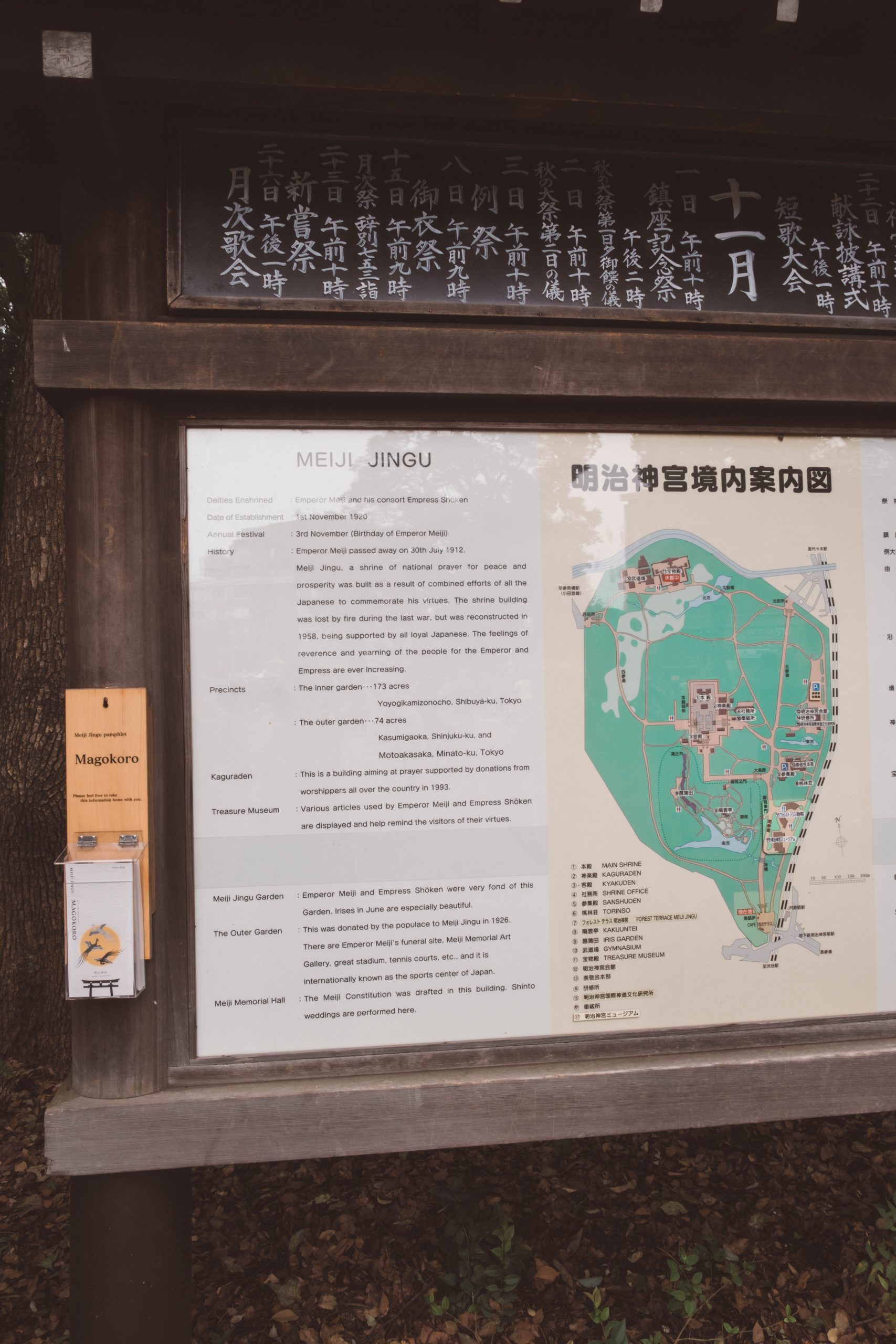
Travel Tips
Early Visits: The shrine usually gets crowded as the day progresses, so visiting early in the day can give you a more peaceful experience.
Appropriate Attire: Although there’s no strict dress code, wearing modest attire shows respect for the religious site. Ideally, you will have your shoulders covered and you’ll avoid wearing sandals without socks.
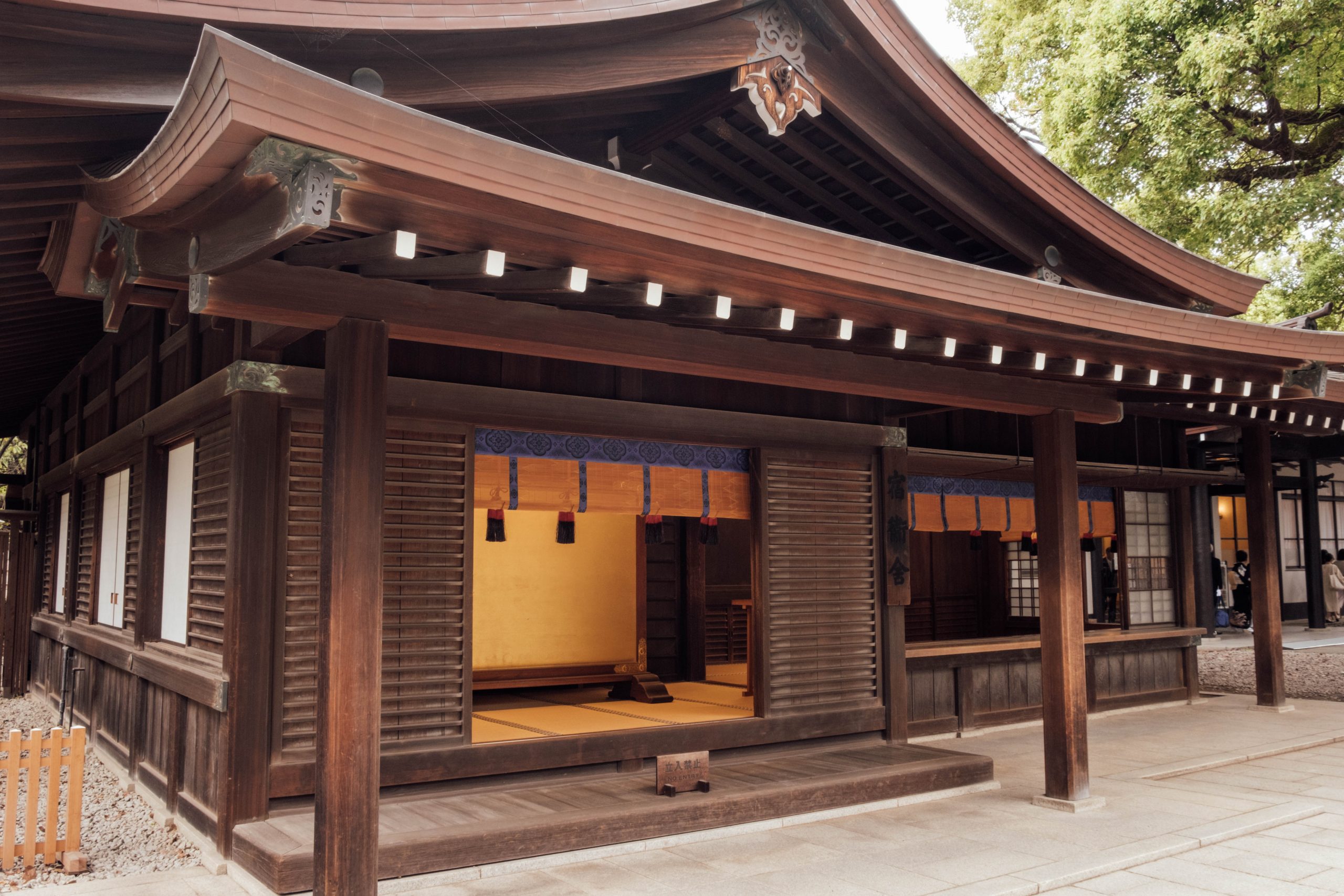
Photography: While photography is allowed in most outdoor areas, it may be restricted inside certain buildings. Always look for signs or ask staff members. Some events will specifically have a no photo signs displayed. Photography is prohibited in front of the main shrine where people are praying. Please also refrain from taking photos of the amulet office. If the staff asks you to stay back when a wedding takes place, please respect this and make sure to take photos without flash.
Special Events: Keep an eye on the shrine’s event calendar above, as there are numerous ceremonies and festivals that take place throughout the year.
Food and souvenirs
There are several options for food and souvenirs at Meiji Jingu Shrine. If you want a coffee and a small bite, the best option is the CAFÉ Mori no Terrace. It’s located right at the entrance before the main torii. It can get busy during lunch time.
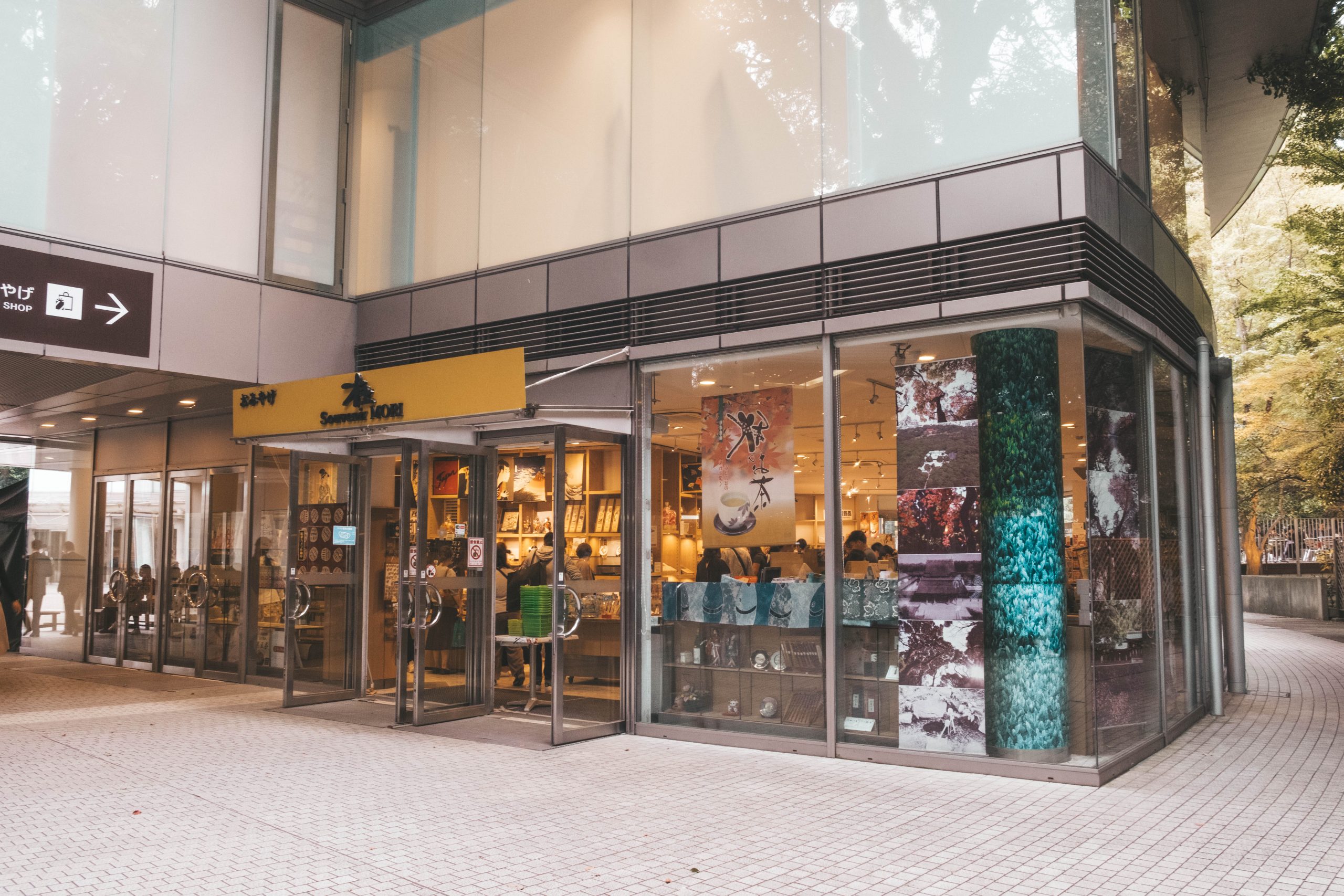
For a more substantial meal head to Forest Terrace Meiji Jingu where you can find Restaurant Yoyogi. It’s perfect for lunch. Occasionally, you will find small stalls in front of the forest terrace selling Japanese traditional foods like dango and ice creams.
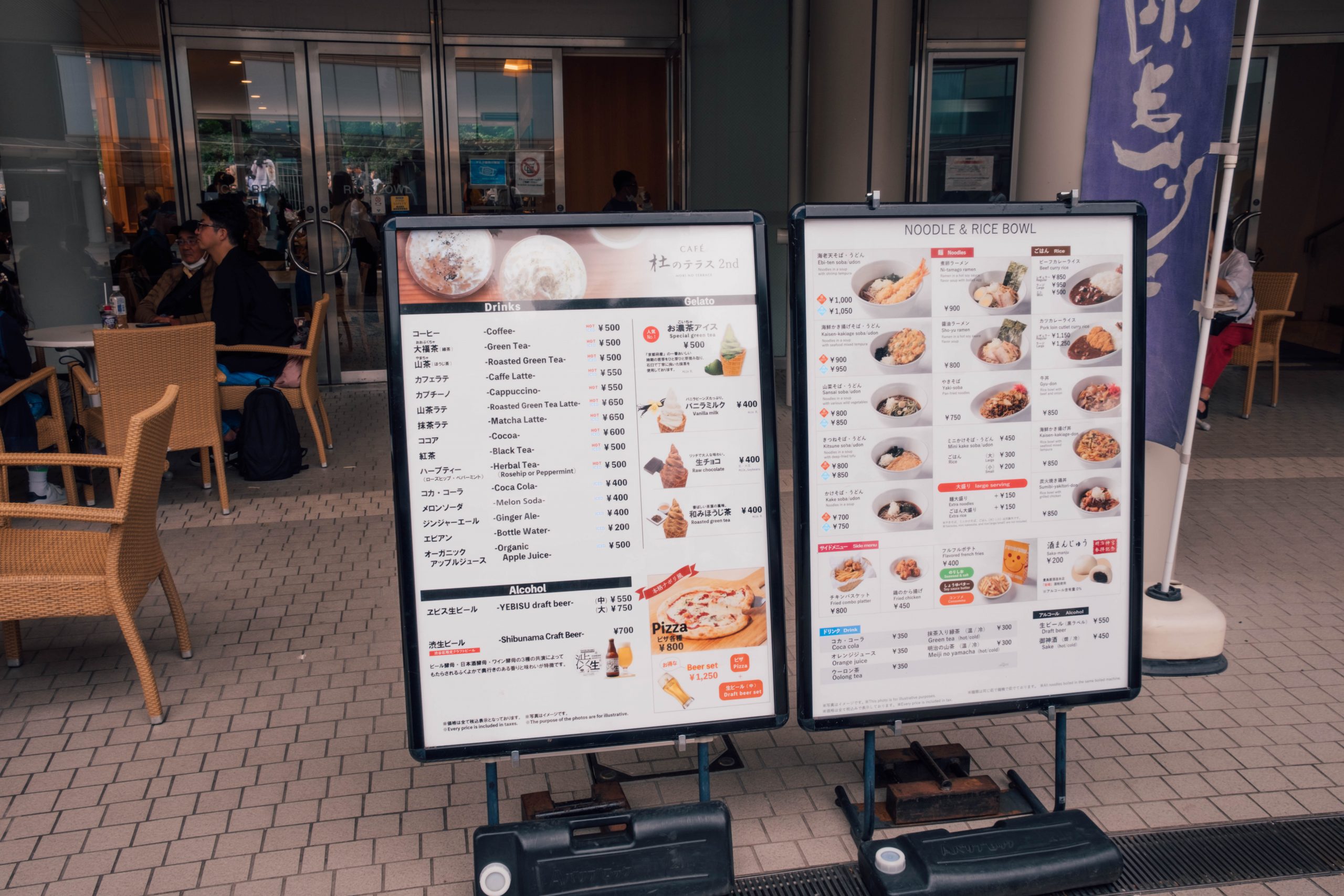
For souvenirs, head to Forest Terrace Meiji Jingu and enter Mori souvenir shop where you can find all sort of perfect Japanese souvenirs including small Omamoris.
Entrance Fees and Hours
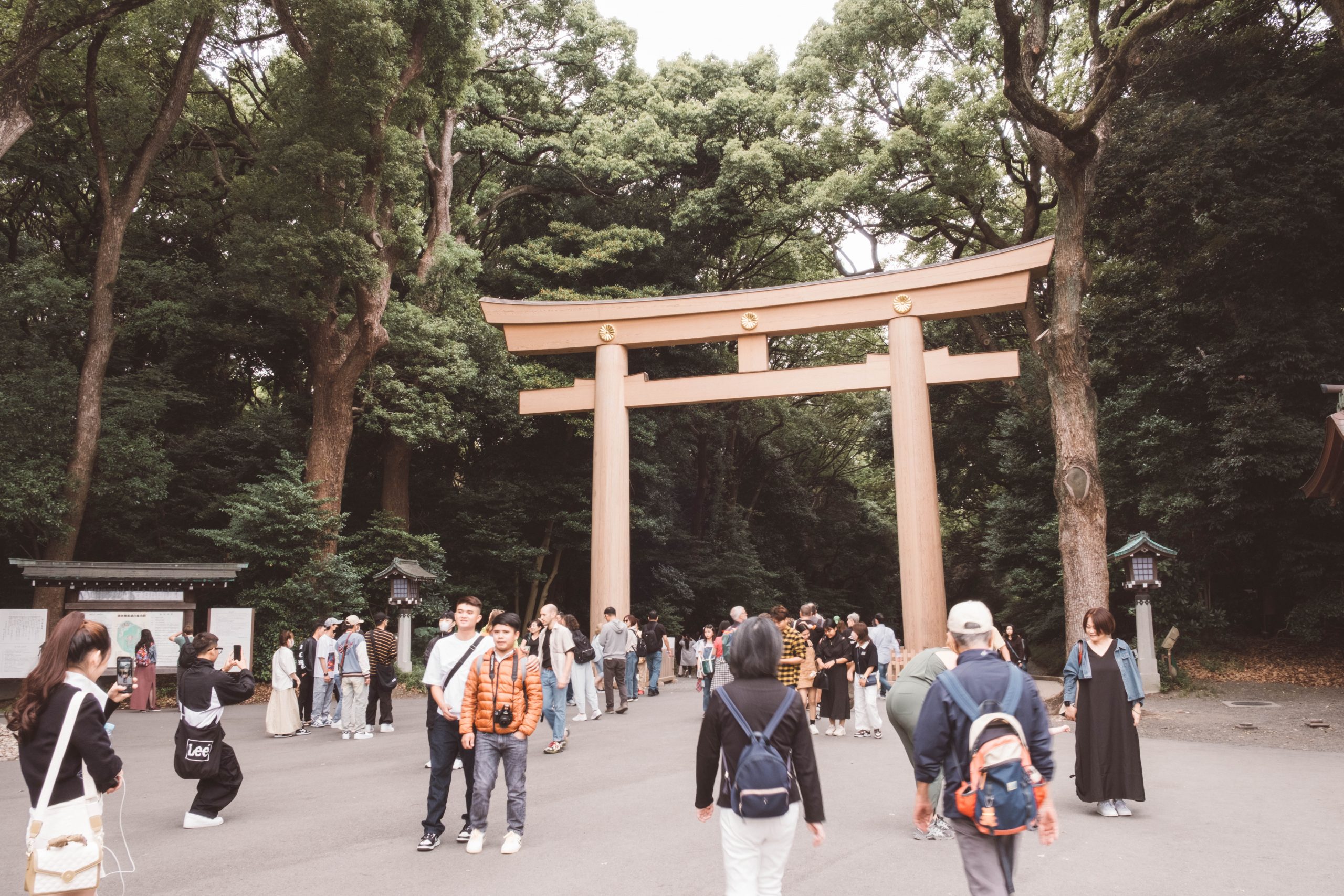
Meiji Jingu Shrine
🆓 There is no entrance fee to the main Meiji Jinju Shrine.
⏰ Hours: From dawn 🌅 to dusk 🌇
🗓️ Closed: No closing days
💵 Admission: Free
Inner Garden
⏰ Hours: 9:00 to 16:30 (until 16:00 from November to February)
Note: Admission ends 30 minutes before closing ⚠️
Special Hours: Extended operating times in the middle of June 📆
🗓️ Closed: No closing days
💵 Admission: 500 yen
Meiji Museum
⏰ Hours: 10:00 to 16:30
Note: Admission ends 30 minutes before closing ⚠️
🗓️ Closed: No closing days
💵 Admission: 1000 yen (Adults), 900 yen (High school students or younger).
Frequently Asked Questions
Is Meiji Jingu worth visiting?
Meiji Jingu Shrine is a good place to visit if you’re in Tokyo. It’s important for its history and shows you a lot about Japan’s religion and culture. The shrine is set in a forest, so it’s a quiet spot away from the city. It has traditional Japanese buildings and big gates that are worth seeing.
Even if you’re not religious, the place has a calm feeling that many people like. They also hold special ceremonies throughout the year. Getting there is easy; it’s close to two train stations with Harajuku being the most convenient.
The main area doesn’t cost anything to enter, so it’s an affordable attraction in Tokyo. If you like taking photos, there are plenty of good spots. There’s also a museum that tells you more about the shrine and the emperor and empress it honours. Plus, it’s close to other places you might want to visit, like Takeshita Street in Harajuku. So it’s a good stop to add to your trip.
What is the Meiji Jingu famous for?
Meiji Jingu Shrine is famous for being one of Tokyo’s most significant religious sites. It’s dedicated to Emperor Meiji and Empress Shoken and is a prime example of Shinto architecture. The shrine is known for its large forested area, which is rare in a bustling city like Tokyo. It’s a popular place for traditional Shinto weddings and other ceremonies that you can sometimes witness when visiting. The shrine is also noted for its Torii gates, which are some of the largest in Japan. Many people visit Meiji Jingu for spiritual reasons, but it’s also a top spot for tourists who want to experience Japanese culture and history. It’s close to Harajuku, making it easily accessible for visitors. The shrine’s grounds also include a museum and a beautiful inner garden, adding to its appeal.
What is Meiji Jingu?
Meiji Jingu is a Shinto shrine in Tokyo, Japan, dedicated to Emperor Meiji and his wife, Empress Shoken. It’s one of the city’s major religious and tourist sites. Built in 1920, the shrine has historical importance and gives insight into Japanese culture and religion. It is set in a large forested area, providing a quiet place away from the busy city life. The shrine features traditional Japanese architecture, including large wooden Torii gates. It’s a common location for Shinto weddings and holds various ceremonies throughout the year. The shrine is easily accessible, being close to Harajuku and Meiji-Jingumae train stations. Entrance to the main part of the shrine is free, and there’s also a museum and a paid inner garden on the grounds.
Is Meiji Jingu free to enter?
Yes, entry to the main area of Meiji Jingu Shrine is free. There is no admission fee for the central shrine grounds where you can see the main hall and various other features. However, there is a separate inner garden within the shrine complex that does require a small entrance fee (500 yen) if you wish to visit it. The Meiji Jingu Museum, which is also on the shrine grounds, has its own admission fee as well (1000 yen).

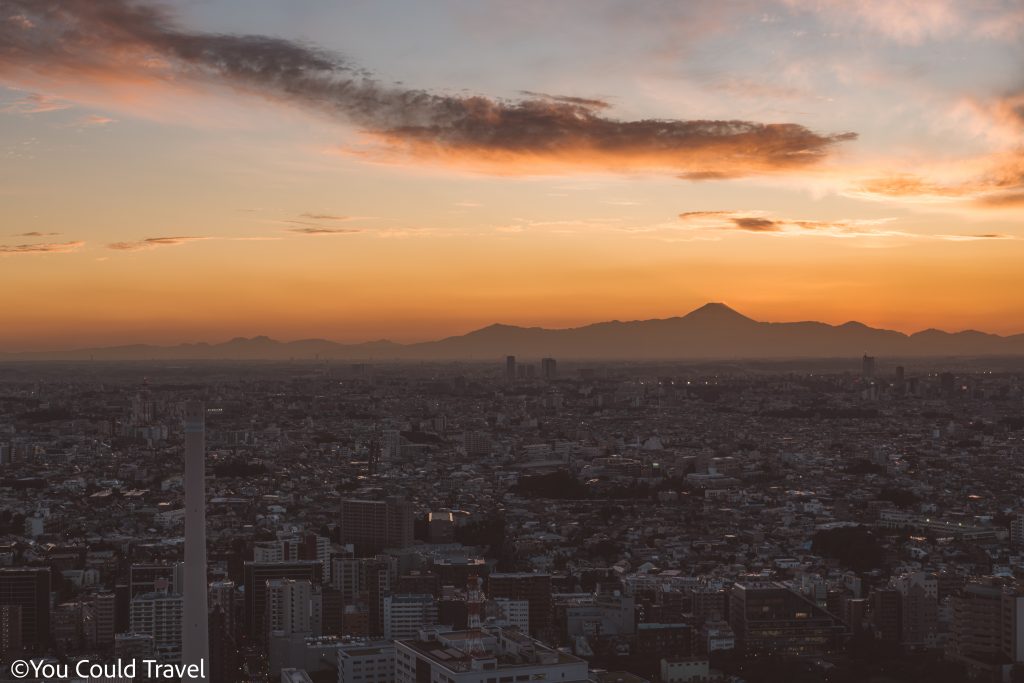
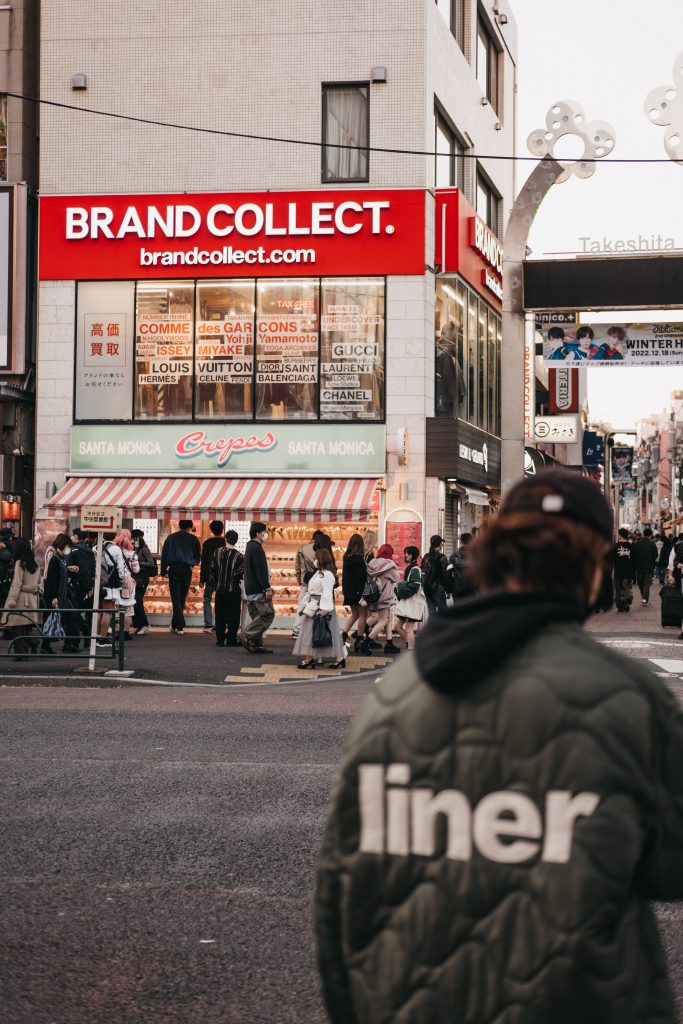
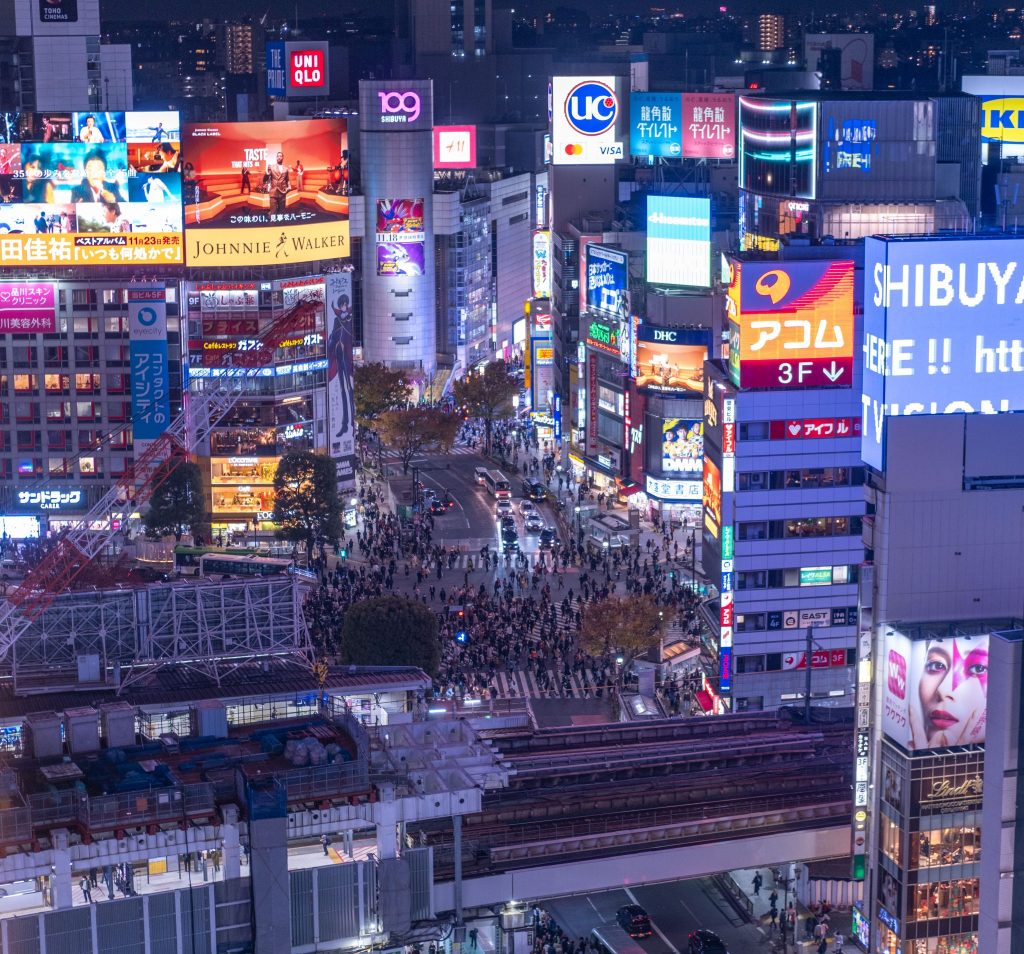
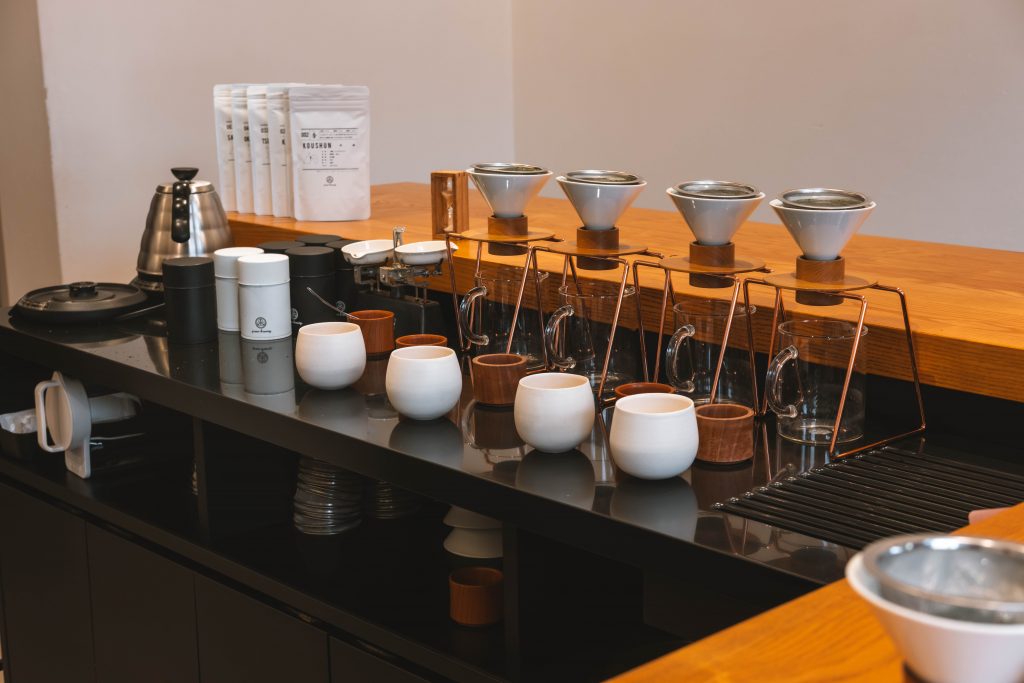
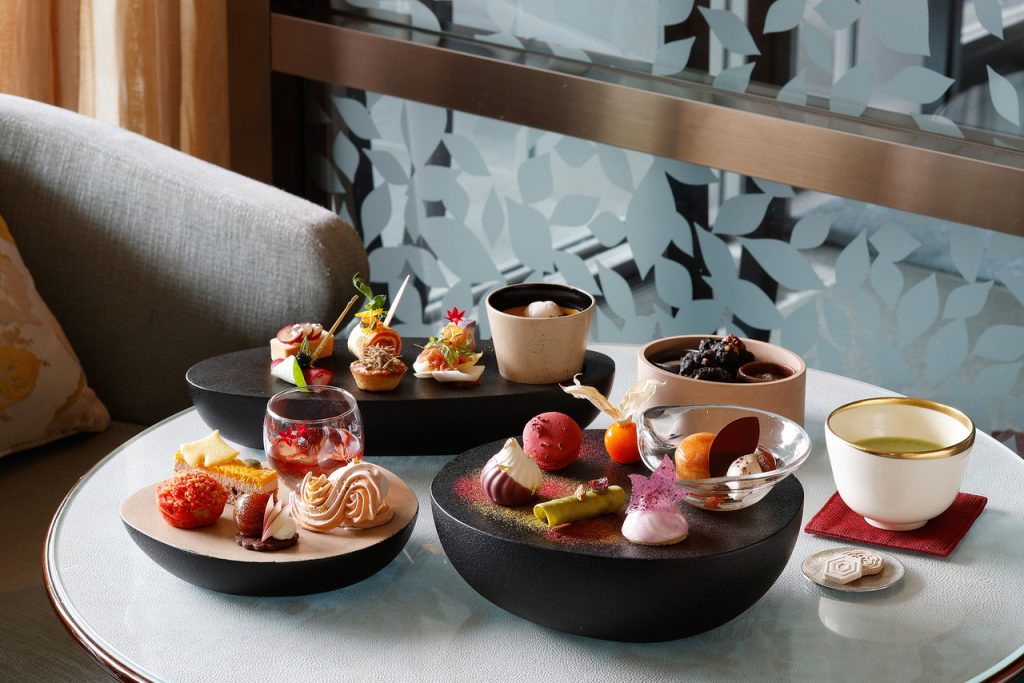
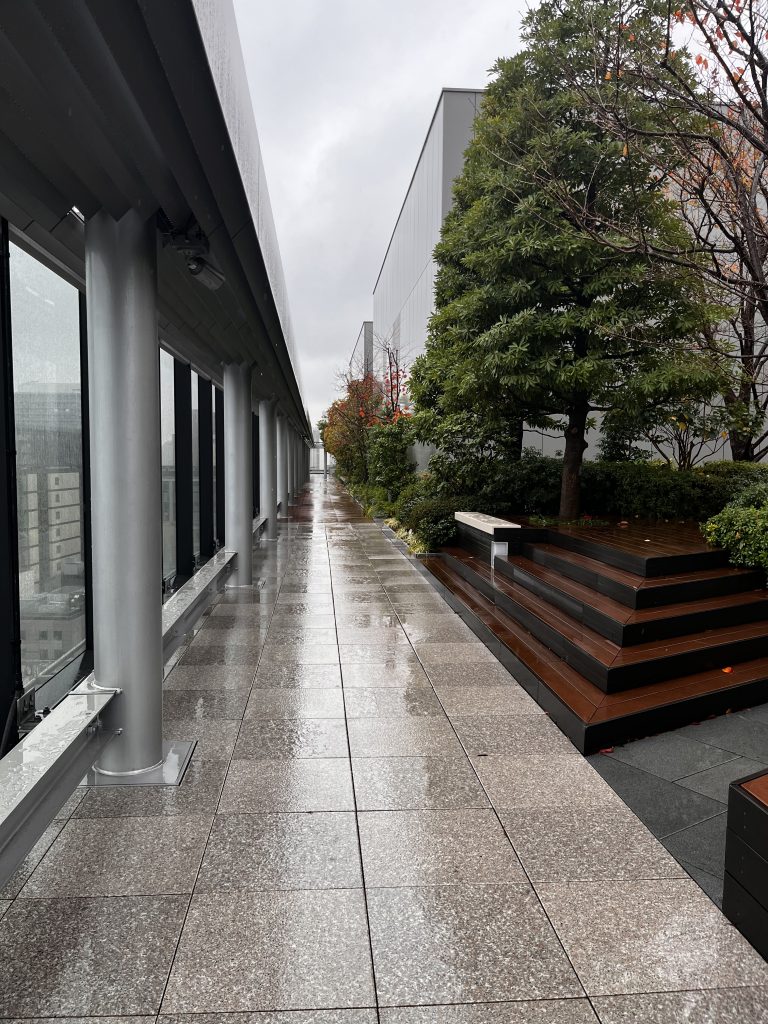


Leave a Reply